31 Latest Affiliate Marketing Statistics For 2024: The Definitive List

Curious about the latest affiliate marketing statistics?
Affiliate marketing is one of the most effective revenue sources influencers, creators and bloggers alike can use to diversify their revenue streams.
However, the affiliate marketing statistics in this post prove that it’s also an effective marketing strategy for brands to use to increase sales and spread brand awareness across multiple marketing channels.
In this post, we list the top affiliate marketing statistics brands and publishers alike can use to optimize their marketing strategies.
Editor’s top picks – affiliate marketing statistics
- By 2027 the global affiliate marketing industry is expected to grow to a market size of $27.78B. (Proficient Market Insights)
- The average salary of an affiliate marketer is $54,251/year. (PayScale)
- According to 80% of brands an important source of revenue is through affiliate marketing. (Digiday x AWIN)
- 28% of affiliate marketers use blogs to promote affiliate links. (Statista)
- Affiliate marketing helps with brand awareness according to 58% of brands. (Digiday x AWIN)
General affiliate marketing statistics
1. The global affiliate marketing industry is expected to grow to a market size of $27.78B by 2027
A report published by Proficient Market Insights predicts the global affiliate marketing industry to grow to a market size of $27.78B by 2027 at a compound annual growth rate of 9.89%.
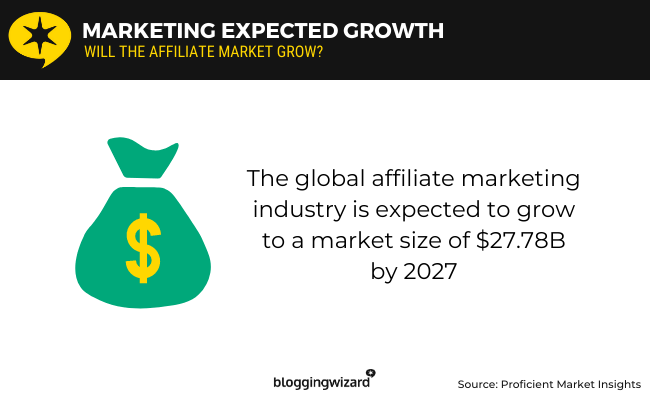
The market size was valued at $15.77B in 2021.
The report also lists a few major players in the affiliate marketing industry, including Shopify, Avangate Affiliate Network, Amazon, ShareASale, Taobao, Clickbank, AWIN, Bluehost, Convertkit, Rakuten Marketing and more.
Source: Proficient Market Insights
2. 49% of brands work with affiliate marketers
Aspire’s State of Influencer Marketing report for 2022 revealed that, other than social media influencers, nearly 50% of brands work with affiliate marketers to increase sales and expand brand recognition to social media.
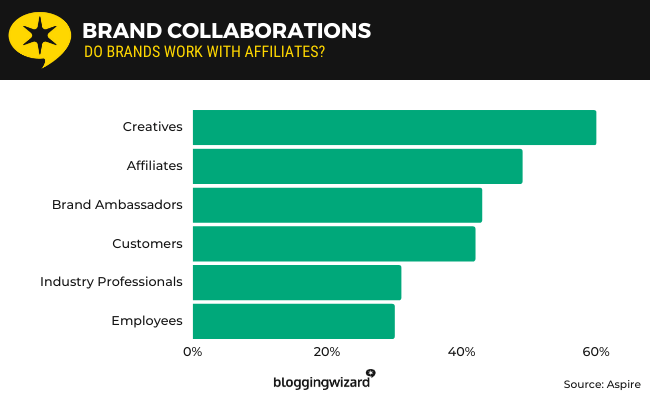
60% work with creatives, and 43% work brand ambassadors.
Source: Aspire
3. 17% of brands spend 80-100% of their marketing budgets on affiliate marketing
Affiliate marketing budgets are growing.
According to AWIN’s survey of 100 brands, 17% of brands say they spend 80 to 100% of their marketing budgets on affiliate marketing alone.
This was an 8% increase from the previous year’s survey.

The majority of brands, 34% to be exact, say their affiliate marketing spend falls between 21 and 40% of their marketing budgets.
Source: Digiday x AWIN
4. Amazon Associates is the leading affiliate program with over 900,000 members
According to data from Statista, Amazon Associates is the most popular affiliate program worldwide.
Over 900,000 marketers have joined this program, putting ShareASale in second with over 700,000 members.
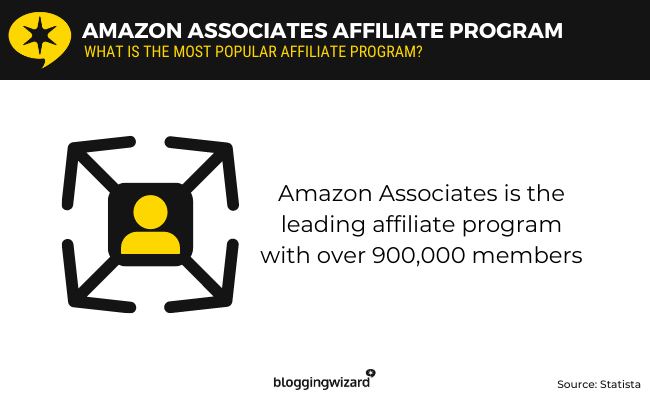
Source: Statista1
5. Interest in affiliate marketing has been growing since mid-2020
Google Trends’ data shows that searches for the term “affiliate marketing” started to increase in 2016 before rising sharply a few months into the COVID-19 pandemic in 2020.
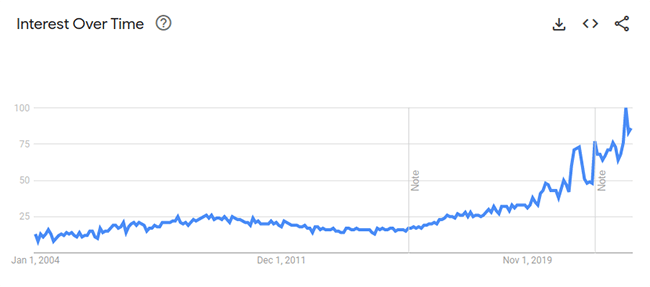
Interest in this term has been rising steadily ever since.
Interest is highest in Nigeria, Bangladesh, Kenya, Jamaica and Ghana.
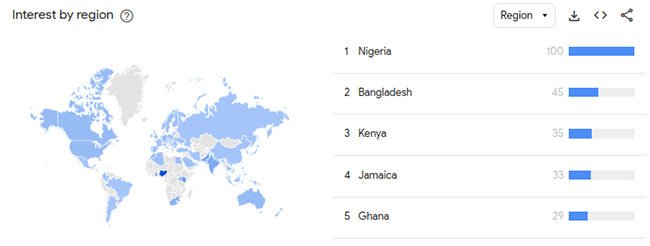
Source: Google Trends
6. 13.8% of all Instagram affiliate marketers operate in the lifestyle niche
Influencer Marketing Hub’s surveys on influencer marketing have revealed that of Instagram influencers who earn affiliate income, 13.8% are in the lifestyle niche.
This is one of the most consistent affiliate marketing trends as the lifestyle niche also made up the highest market share of Instagram affiliate marketers (11.59%) in the previous year’s survey.
Other top affiliate niches on Instagram include beauty, music, photography, family and entertainment.
Source: Influencer Marketing Hub
7. 73% of affiliate marketers prefer to join in-house affiliate programs
Influencer Marketing Hub asked influencers about the types of affiliate programs they prefer to join and gave respondents two choices: SaaS and network.
Only 27% of influencers prefer joining affiliate networks, which are affiliate platforms that have dozens, hundreds and even thousands of affiliate programs you can apply for and manage form a single affiliate account.
73% prefer joining in-house programs brands operate themselves, usually with a SaaS application.
Source: Influencer Marketing Hub
Affiliate marketing revenue statistics
8. 31% of the top 3 publishers in the United States name affiliate marketing as a top revenue source
eMarketer asked the top publishers in the United States about their most significant sources of revenue.
31% of those ranked as a top-three publisher said affiliate marketing is a primary source of revenue while only 9% of the top publishers said the same thing.
Affiliate marketing was beat by ecommerce (voted by 62% of the top three publishers), subscriptions and memberships (58%), and monetizing first-party data in a second-party marketplace (38%).
Source: eMarketer
9. The average salary of an affiliate marketer is $54,251/year
According to data collected by PayScale, the average salary of an affiliate marketer working in the United States is $54,251/year.
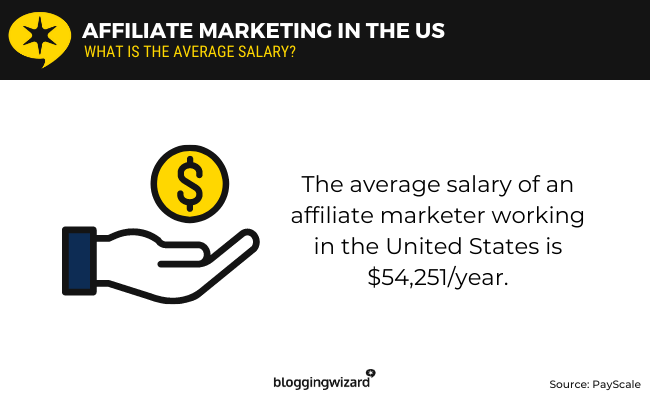
This data is based on over 7,600 salary profiles listed on the site.
The pay range for this profile is $40,000 to $75,000/year.
Source: PayScale
10. 57.55% of marketers worldwide earn less than $10,000 from affiliate marketing
A survey conducted in 2021 revealed that 57.55% of affiliate marketers, or most affiliate marketers, earn less than $10,000 from affiliate marketing efforts.
The survey also revealed that one out of six make as much as $50,000 while only 4% earn over $150,000 from affiliate marketing.
Source: Statista2
11. 44% of affiliate revenue is accrued by the retail industry alone
Influencer Marketing Hub’s research revealed that 44% of all affiliate revenue is generated by the retail sector.
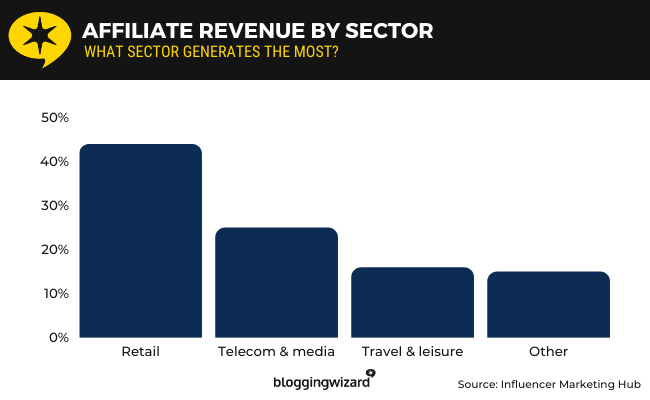
25% is generated by the telecom and media sector while 16% is generated by the travel and leisure industry.
Source: Influencer Marketing Hub
12. The home and garden industry has an affiliate revenue growth rate of 209.72% year over year
Influencer Marketing Hub’s research included data sourced from Refersion.
They found that the home and garden industry had the highest growth rate as far as affiliate revenue grows.
The industry experienced a growth rate of 209.72% year over year between 2021 and 2022.
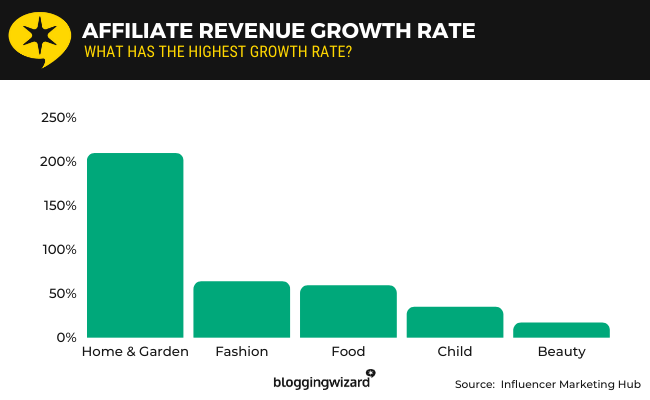
Other industries that experienced higher growth rates were fashion (63.87%), food (59.57%) and child (35.06%).
The beauty industry experienced the lowest growth rate at 17.24%.
Source: Influencer Marketing Hub
13. 63% of marketers worry about affiliate marketing fraud
When Influencer Marketing Hub surveyed marketers, they asked respondents a yes-or-no question about whether or not they worried about affiliate marketing fraud.
63% of respondents said yes, and 30.9% admitted to having experienced affiliate marketing fraud in past campaigns.
This means a majority of marketers worry about affiliate partners utilizing chargeback fraud, fake lead fraud and cookie stuffing to inflate their commissions.
Source: Influencer Marketing Hub
14. Marketers lost $1.4B in revenue in 2020 due to affiliate marketing fraud
Affiliate marketers’ concerns about experiencing affiliate marketing fraud are not unfounded.
In fact, CHEQ’s data found that marketers lost $1.4 billion in revenue in 2020 alone due to affiliate marketing fraud.
This was part of a total revenue loss of $23 billion due to ad fraud.
One of the highest instances of affiliate marketing fraud cited by the report was committed by eBay super affiliate Shawn Hogan, who owned an online marketing company called Digital Point Solutions.
Hogan used cookie stuffing to artificially inflate the number of commissions he was referring to eBay’s marketplace.
By the time he was found out, he had defrauded eBay of over $28 million in affiliate commissions.
Source: CHEQ
15. Mountain Rose Herbs used their affiliate marketing program to increase revenue by $330,000
Aspire did a case study with Mountain Rose Herbs, who had an affiliate marketing program that offered a 10% commission rate at the time.
After a successful affiliate marketing campaign, the brand experienced an increase in revenue by $330,000.
The campaign also generated over 95,000 clicks and 900 conversions.
Source: Aspire
16. It’s a Lovely Life generated $103,720.49 in affiliate income in August 2019
In our post, What is Affiliate Marketing?, we listed a small collection of data detailing how affiliate marketing generates a sizeable income for small and large blogs alike.
The top source came from the blog It’s a Lovely Life, who earned a total revenue of $222,857 from their blog in August of 2019 alone.
Of that revenue, $103,720.49 came from affiliate marketing alone.
The blogger in question states this income was generated by participate in affiliate programs from Tailwind, Picmonkey, Fiverr, Amazon, Bluehost, Warfare Plugins, Grammarly, Constant Contact, Semrush and “numerous travel-related affiliate programs.”
This demonstrates the importance of diversifying your affiliate profile as well as utilizing affiliate programs that make sense for your target audience.
If you go down the list in that post, you’ll see how affiliate marketing plays a huge role in a blog’s ability to generate income.
It reveals how affiliate marketing accounts for anywhere from 25-50% of a blog’s revenue stream.
Source: Blogging Wizard
17. Affiliate marketing companies have received $1.5B in funding from investors
Crunchbase’s data reveals that affiliate marketing companies have received more than $1.5 billion in funding from over 230 funding rounds.
This data comes from over 1,070 organization profiles on Crunchbase.
99% are for-profit companies.
Source: Crunchbase
18. 80% of brands say affiliate marketing is an important source of revenue
When Digiday teamed up with AWIN to publish a report on the State of Affiliate and Partner Marketing in 2023, they surveyed 100 brands and agencies.
They asked respondents to rate the importance affiliate marketing will have as a revenue source on a scale from “it will become significantly less important” to “it will become significantly more important.”
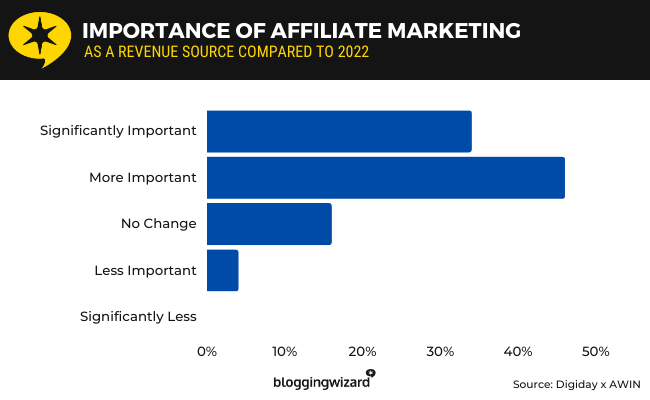
34% of respondents said affiliate marketing will become significantly more important as a revenue source while 46% simply said “it will become more important.”
Only 4% said it will become less important as a revenue source.
Source: Digiday x AWIN
Statistics on affiliate marketing strategies
19. 29% of brands find affiliate marketing to be an effective influencer marketing strategy
As more brands are increasing their affiliate marketing spending, 29% name affiliate marketing as an effective marketing strategy when working with influencers.
It was beaten by paid advertising at 57% and user-generated content at 47%.
Source: CreatorIQ
20. 30% of consumers report buying products promoted by influencers
Data by Pew Research Center revealed that, on average, 30% of consumers have reported buying a product after seeing an influencer post about it on social media.
Women between the ages of 18 and 29 are most likely to buy products promoted by influencers as an average of 50% of women in this age group have reported doing so.
Men over the age of 50 are least likely to buy products promoted by influencers as only 15% have reported doing so.
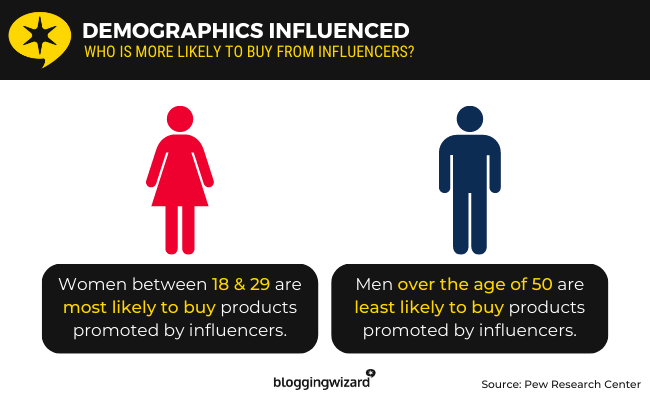
Nevertheless, this data reveals how influencer marketing implemented in the form of affiliate marketing can be an effective marketing strategy for brands.
Source: Pew Research Center
21. 28% of affiliate marketers use blogs to promote affiliate links
While this survey excluded social media, it did reveal that 28% of affiliate marketers use blogs as their primary channel for promoting affiliate links.
18.7% use review sites while 14.8% use coupon sites.
Source: Statista3
22. The SaaS industry distributes the highest commission rates at 70%
Influencer Marketing Hub’s data found that while commission rates for the SaaS industry go as low as 20%, they go as high as 70%.
This is the highest commission rate of any industry.
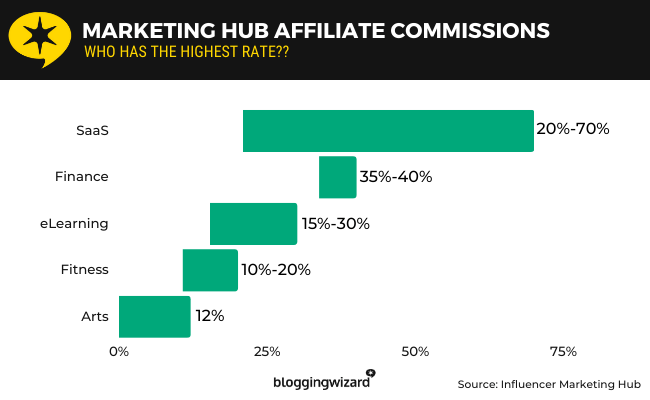
The finance industry issues commission rates between 35 and 40% while commission rates for the elearning industry are between 15 and 30%.
The lowest commission rates go to the fitness industry (10-20%) and the arts industry (12%).
Source: Influencer Marketing Hub
23. 48.9% of affiliate marketing companies pay a flat rate
Influencer Marketing Hub’s survey revealed that 48.9% of companies pay affiliates at a flat rate while 42.4% pay a percentage of sales.
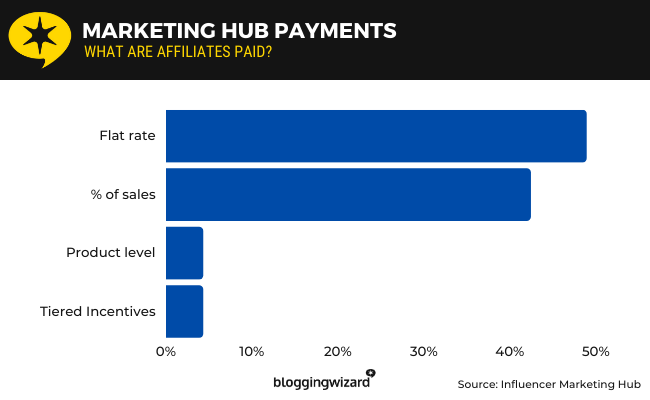
4.3% of companies use product level payments while another 4.3% use tiered incentives.
Source: Influencer Marketing Hub
24. 44% of brands use the first-interaction attribution model for partner marketing campaigns
In Digiday and AWIN’s survey, 100 brands were asked to choose the attribution models they use for partner marketing campaigns.
44% chose first-interaction attribution.
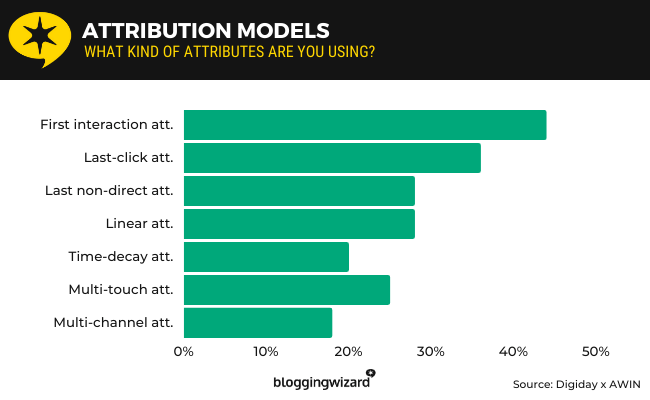
Other options included last-click attribution (36%), last non-direct click attribution (28%), linear attribution (28%) and multi-touch attribution (25%).
Source: Digiday x AWIN
25. 57% of brands deploy technology partners as affiliate partners
AWIN’s survey, published by Digiday, found that 64% of brands use technology partners to achieve higher sales volumes, new customer acquisitions, and more brand awareness and customer loyalty.
They also found that of brands who use technology partners, 57% deploy them as affiliate partners.
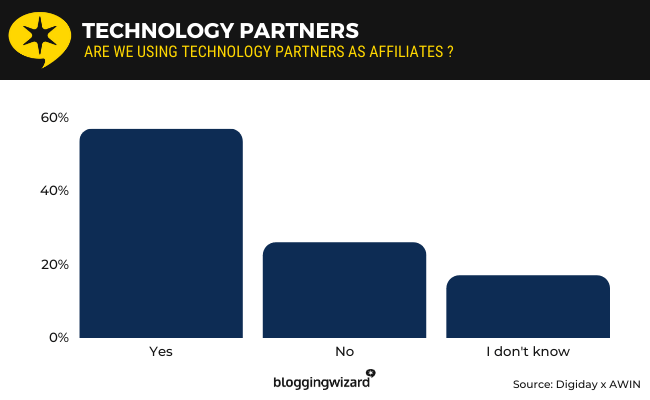
Technology partners are special partnerships brands forge when they need to integrate specific technologies into their business’ workflow, product or website.
These types of partnerships drive growth for both businesses and give non-tech partners access to advanced tech support without the need to hire in-house tech staff.
By also deploying them as affiliate partners, brands encourage tech partners to promote them over other brands they may be partnered with.
Of the 26% of brands who don’t use technology partners as affiliate partners, 31% say they don’t see a need for this type of partnership, and another 31% don’t see a need to implement technology partnerships at all.
22% weren’t aware they could recruit affiliates in this way.
12% don’t think affiliates should be responsible for the customer experience of a business’ website.
Source: Digiday x AWIN
26. 74% of influencers receive compensation from brands via discount codes or affiliate links
CreatorIQ asked influencers about the ways in which brands compensate them for branded content.
74% said brands compensate them by giving them their own discount codes or affiliate links, which they can use to generate commissions.
91% of influencers are gifted free products while 59% have their content reposted by brands, which exposes their content to a wider audience.
The same survey reported that 87% of influencers have posted paid content for brands while 70% have posted unpaid content.
Source: CreatorIQ
27. 40% of brands seek influencers and creators for affiliate partnerships
In AWIN’s survey, the company asked respondents about the types of affiliate partnerships they made in 2022.
40% said they mostly partnered with influencers and creators, but the other options were used just as much.
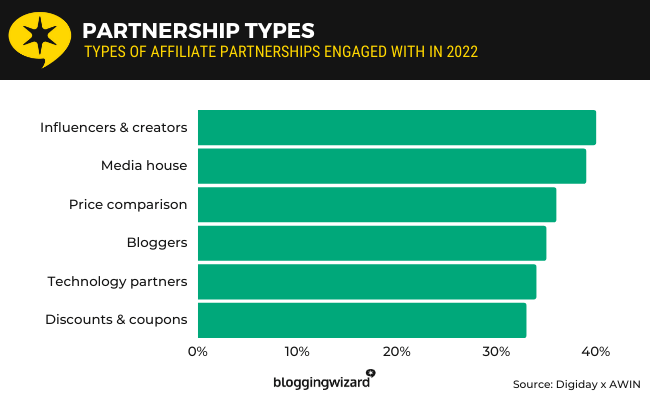
For instance, 39% said they partnered with media houses, 36% said price comparisons, 35% said bloggers, 34% said technology partners, and 33% said discounts and coupons.
Source: Digiday x AWIN
Goal-based affiliate marketing statistics
28. 28% of brands want to see an increase in sales from their marketing efforts
When AWIN asked brands to choose their most significant marketing goals from a list of given options, 28% chose “sales volume.”
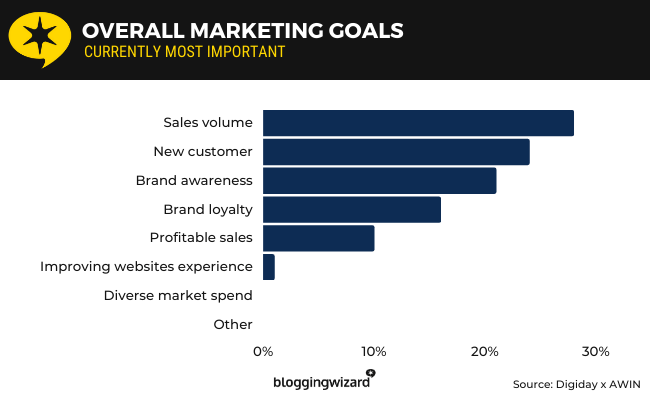
Other goals included in the survey were new customer acquisition (voted by 24% of respondents), brand awareness (21%), brand loyalty (16%), profitable sales (10%), improving on-site customer experience (1%) and diversifying marketing spend (0%).
While it’s important to note that this question is aimed at marketing as a whole as opposed to just affiliate marketing, it shows how affiliate marketing is a key component of a brand’s marketing strategy as its entire purpose is to help brands increase their sales and spread brand awareness by enlisting the support of influential figures and their audiences.
Source: Digiday x AWIN
Related Reading: The Top Brand Loyalty Statistics You Need To Know.
29. 58% of brands say affiliate marketing helps most with brand awareness
AWIN’s survey found that while brands use affiliate marketing to increase their sales volume, the marketing strategy mostly helps with increasing brand awareness, according to 58% of brands.
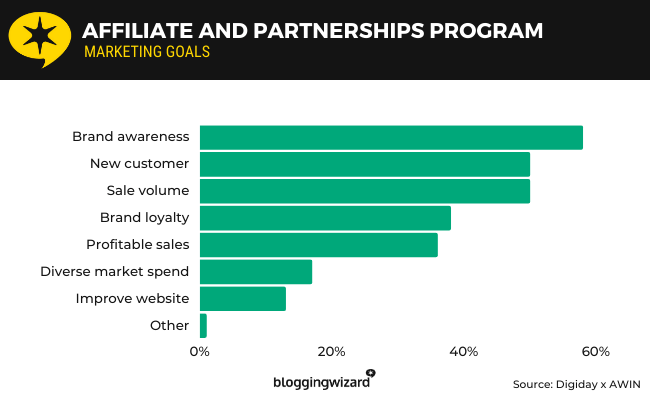
50% of brands say affiliate marketing helps with sales volume while another 50% say it helps with new customer acquisition.
Interestingly, while few brands use affiliate marketing to improve customer experience and no brands use it specifically to diversify their marketing spend, 13% of brands say affiliate marketing helps to improve the on-site customer experience while 17% say it does diversify their marketing spend.
Source: Digiday x AWIN
30. 60% of brands say affiliate marketing helps convert leads
When Digiday and AWIN teamed up to publish a report on affiliate marketing, they discovered that 60% of brands find affiliate marketing to be an effective way to increase conversions from landing pages.
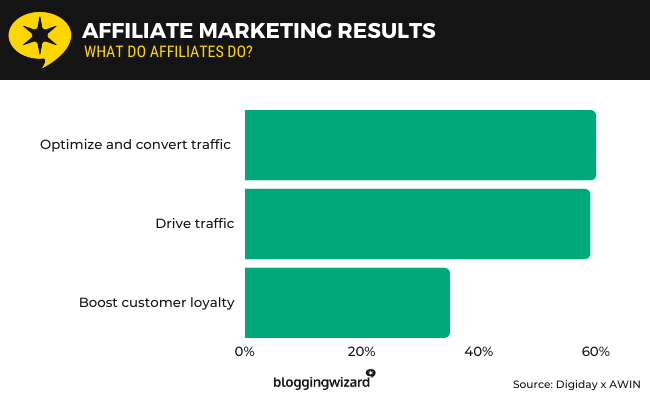
59% even said affiliate marketers generate traffic and leads for those pages.
35% said it boosts customer loyalty.
Source: Digiday x AWIN
31. 59% of brands struggle to understand how affiliate marketing helps other marketing channels
In AWIN’s survey, 100 brands were asked about the challenges they encounter when it comes to measuring the success of affiliate marketing campaigns and applying attribution.
59% of brands say they struggle to understand how affiliate marketing affects other marketing channels they use.
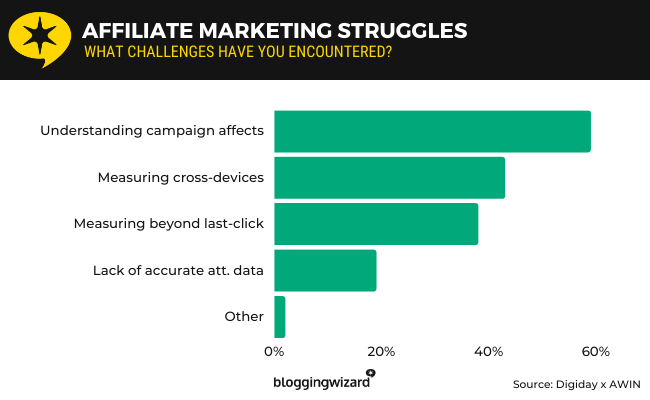
43% say they aren’t able to measure cross-device journeys, and 38% say they aren’t able to measure activity beyond last-click data.
19% don’t have accurate attribution data at all.
Source: Digiday x AWIN
Affiliate marketing statistics sources
Final thoughts
That concludes our list of the top affiliate marketing statistics. Let’s go over a few key takeaways.
The most obvious is how effective affiliate marketing is as a marketing strategy for brands, especially when brands work with influencers from TikTok and Instagram.
Brands can use this marketing strategy as a way to increase sales and brand awareness without gambling on a lump sum paid upfront as is required by traditional advertising channels.
Because of the way affiliate marketing works, brands only need to pay for advertising after affiliates generate sales for them.
These stats also revealed how the vast majority of creators are not optimizing their own affiliate marketing strategies as more than half are earning less than $10,000 from their efforts.
This means two things: there’s still a lot to learn and teach about affiliate marketing, and there’s very little competition at the top.
Lastly, if you’re one of the 58% of brands who struggle with identifying how affiliate marketing affects other marketing channels, consider utilizing a social listening tool like Awario or Brand24.
This will help you monitor the number of brand mentions you receive and how frequently you receive them as influencers promote your brand more and more across numerous social media channels.
For additional reading:
